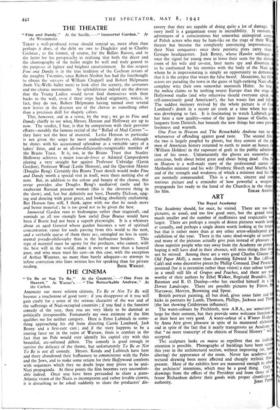ART
The Royal Academy
THE Academy should, for once, be visited. There are too in pictures, as usual, and too few good ones, but the grand tota much smaller and the number of inoffensive and respectable w larger. There are perhaps a couple of dozen pictures worth 1 at casually, and perhaps a single dozen worth looking at for longe but that is rather more than at any other artist-adjudicated gr exhibition of the year. There is the same dead-weight of nonen and many of the pictures actually give pain instead of pleasure ; those superior people who stay away from the Academy on prino hoping it will have died in their absence, will miss things that sit not be missed. Among these are a very good Charles Ginner ( Old Paper Mill), a more than charming Edward le Bas (All-n Café) and some decorative pieces,by Philip Connard. Dod Procter invented (for it is invention rather than vision) a nice colour ha in a small still life of Grapes and Peaches, and there are w' worthy of their authors by Ethel Walker, Reginald Brundrit, Bateman and R. 0. Dunlop—who has excelled himself in a I Dorset Landscape. There are possible pictures by Fitton, Narraway, Mervyn, Browning and Spear.
British portrait painting, all but dead, gives some faint and fi kicks in portraits by Lamb, Thomson, Phillips, Jackson and Tho (the last showing Coldstream influence).
The water-colours by Pitchforth, new A.R.A., are sometimes large for their content, but they provide some welcome freedom at their best are very good. A water-colour of a Winter Hedg by Anna Airy gives pleasure in spite of its mannered elaborat and in spite of the fact that it nearly transgresses an Academy that "no mere transcript of the objects of Natural History" will accepted. The sculpture looks en masse so repellent that no indic attention is possible. Photographs of buildings have been acc this year in the architectural section, without improving (or, id altering) the appearance of the room. Never has academic a tectural drawing been more affected and cheaply stylistic than present. Most of the exhibits here are mannered enough to o the architects' intentions, which may be a good thing. Only drawings from the offices of the President and from those of fessor Richardson deliver their goods with proper cleanliness authority. JOHN Pit






















 Previous page
Previous page